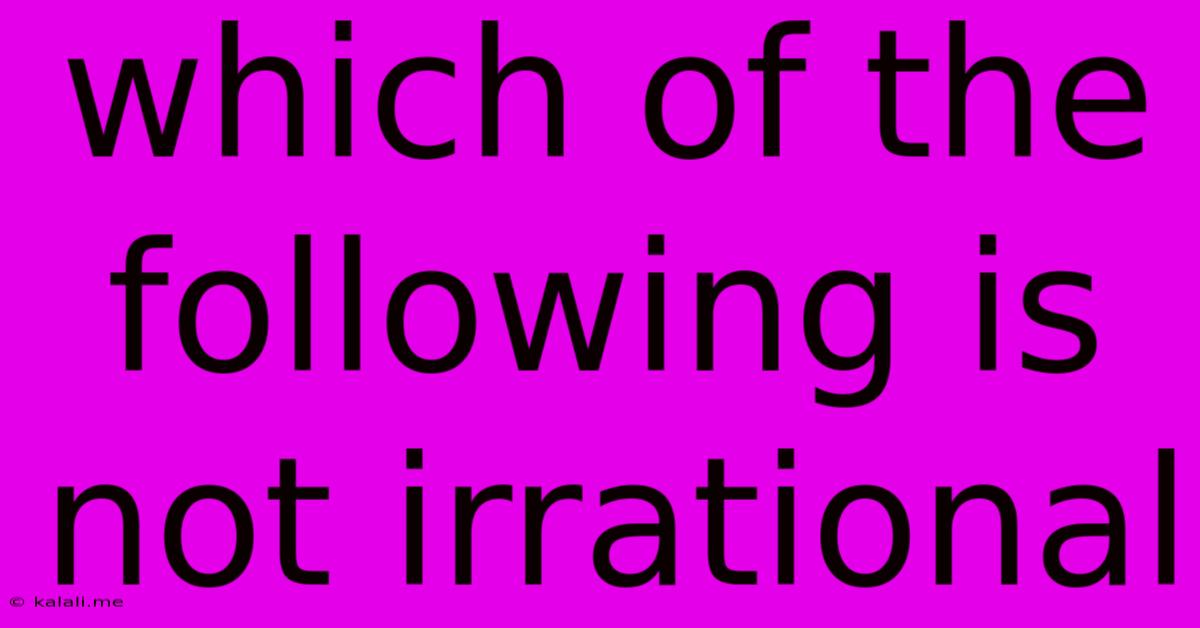Which Of The Following Is Not Irrational
Kalali
Jun 15, 2025 · 2 min read

Table of Contents
Which of the Following is Not Irrational? Understanding Rational and Irrational Numbers
This article will explore the concept of rational and irrational numbers, clarifying the key differences and providing examples to help you easily identify which numbers belong to each category. Understanding this distinction is crucial in mathematics and many related fields. We will delve into the definition, characteristics, and examples of both rational and irrational numbers, ultimately enabling you to confidently determine which of a given set is not irrational.
What are Rational Numbers?
Rational numbers are numbers that can be expressed as a fraction p/q, where 'p' and 'q' are integers, and 'q' is not equal to zero. This means they can be written as a simple fraction, a terminating decimal (like 0.75), or a repeating decimal (like 0.333...). Examples of rational numbers include:
- 1/2 (one-half)
- 0.75 (three-quarters)
- -3 (can be written as -3/1)
- 2.666... (two and two-thirds)
- 0 (zero, can be written as 0/1)
What are Irrational Numbers?
Irrational numbers are numbers that cannot be expressed as a fraction of two integers. Their decimal representation is non-terminating and non-repeating; it goes on forever without any pattern. Famous examples include:
- π (pi): Approximately 3.14159..., the ratio of a circle's circumference to its diameter.
- √2 (square root of 2): Approximately 1.414..., a number which, when multiplied by itself, equals 2.
- e (Euler's number): Approximately 2.718..., the base of natural logarithms.
- Φ (the golden ratio): Approximately 1.618..., a number with unique mathematical properties.
Identifying the Non-Irrational Number
When presented with a list of numbers, determining which is not irrational involves checking each number to see if it fits the definition of a rational number. If it can be expressed as a fraction p/q (where p and q are integers, and q ≠ 0), then it is rational and therefore not irrational.
Example:
Let's say you have the following set of numbers: π, 3/4, √5, 0.666...
- π: This is a well-known irrational number.
- 3/4: This is a rational number because it's already expressed as a fraction of integers.
- √5: This is an irrational number.
- 0.666...: This is a rational number; it's a repeating decimal representing 2/3.
In this example, 3/4 and 0.666... are not irrational.
Conclusion:
Distinguishing between rational and irrational numbers is a fundamental concept in mathematics. By understanding the definitions and characteristics of each, you can confidently identify which numbers are rational and which are irrational. Remember to look for fractional representation or terminating/repeating decimals as indicators of rational numbers. Practice identifying rational and irrational numbers in different contexts to solidify your understanding.
Latest Posts
Latest Posts
-
Which Of The Following Are Characteristics Of Public Goods
Jun 15, 2025
-
Subcooling The Liquid Refrigerant Increases System Efficiency By
Jun 15, 2025
-
Application Letter For Scholarship Request Pdf
Jun 15, 2025
-
Application To Close The Bank Account
Jun 15, 2025
-
Which Sphere Is Composed Of All Living Organisms
Jun 15, 2025
Related Post
Thank you for visiting our website which covers about Which Of The Following Is Not Irrational . We hope the information provided has been useful to you. Feel free to contact us if you have any questions or need further assistance. See you next time and don't miss to bookmark.